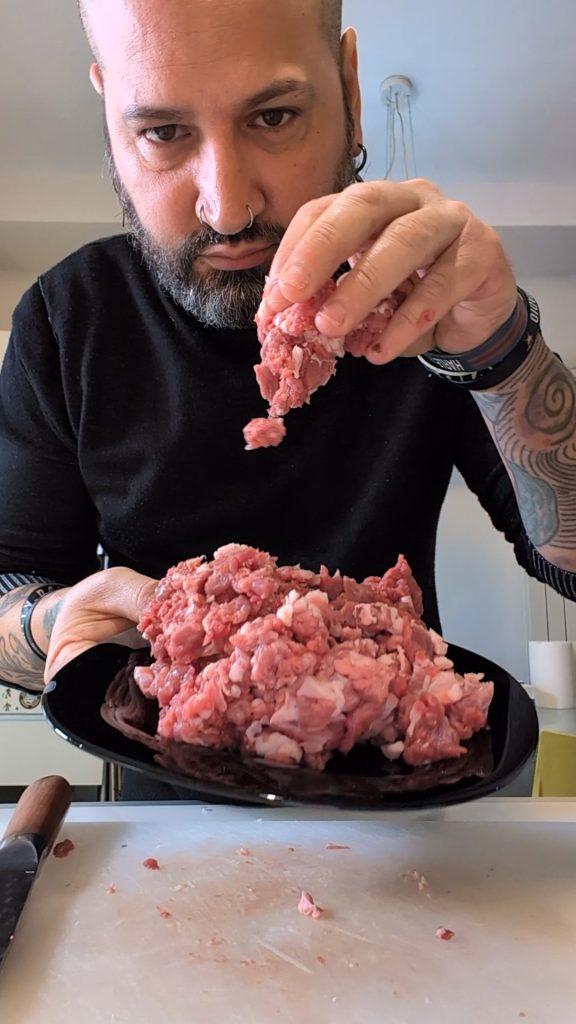When Easter approaches, the festive aroma fills our kitchens, and the desire to share special moments is strong.
This year, imagine bringing to the table a classic that warms the heart: the Lamb Ragù Lasagna Recipe: A Traditional and Tasty Main Course.
A triumph of layers of fresh pasta, a rich lamb ragù, and a comforting béchamel, capable of turning every occasion into an unforgettable memory.
Personally, I can’t wait to return home to my family, where I know I’ll be welcomed by the unmistakable aroma of my mom’s lasagna and the brisk air of Easter.
Whether to celebrate Easter or simply to enjoy a Sunday family lunch, this lasagna is the promise of a culinary experience that speaks of home, tradition, and pure pleasure.
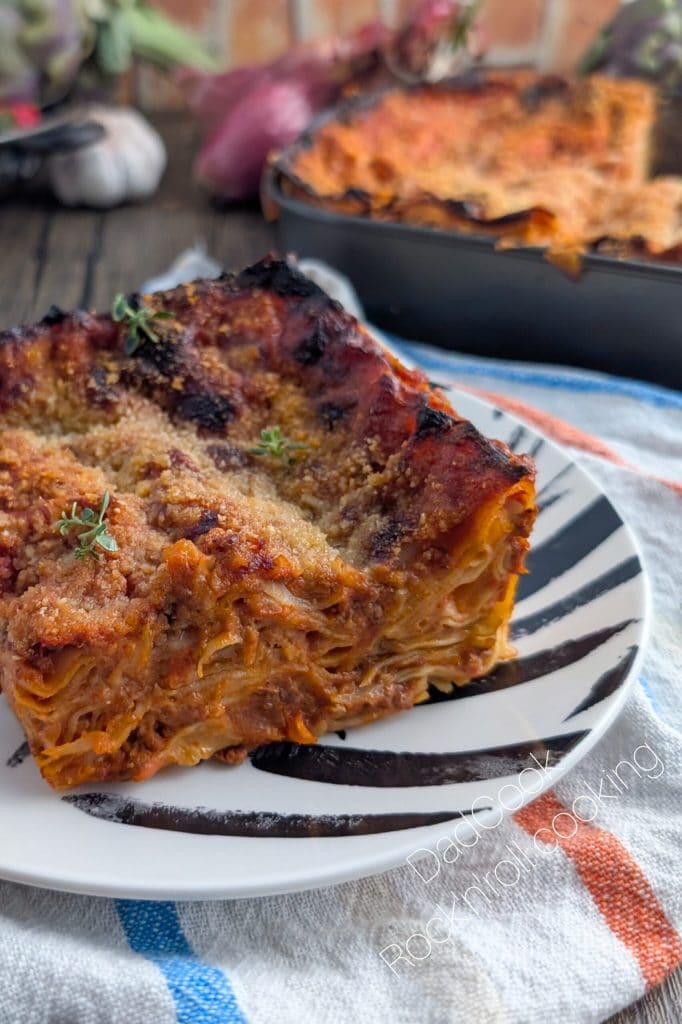
- Difficulty: Very Easy
- Cost: Medium
- Rest time: 10 Minutes
- Preparation time: 30 Minutes
- Portions: 4
- Cooking methods: Slow Cooking, Oven
- Cuisine: Italian
- Seasonality: Easter, All Seasons
- Energy 553.05 (Kcal)
- Carbohydrates 30.38 (g) of which sugars 4.92 (g)
- Proteins 24.26 (g)
- Fat 37.49 (g) of which saturated 14.20 (g)of which unsaturated 20.54 (g)
- Fibers 2.46 (g)
- Sodium 570.99 (mg)
Indicative values for a portion of 390 g processed in an automated way starting from the nutritional information available on the CREA* and FoodData Central** databases. It is not food and / or nutritional advice.
* CREATES Food and Nutrition Research Center: https://www.crea.gov.it/alimenti-e-nutrizione https://www.alimentinutrizione.it ** U.S. Department of Agriculture, Agricultural Research Service. FoodData Central, 2019. https://fdc.nal.usda.gov
Ingredients
Here’s everything you’ll need to create this delicious lasagna: fresh and quality ingredients for a result that will win everyone over.
- 1.65 lbs lamb (Shoulder or leg)
- 2 onions
- 2 carrots
- 1 stalk celery
- 1 clove garlic
- 2.11 cups tomato sauce
- 1 glass red wine
- 3 leaves bay
- to taste extra virgin olive oil
- 1 pinch salt
- 1 pinch black pepper
- 3.17 cups milk
- 5.29 tbsp butter
- 5.29 tbsp flour
- 1 pinch nutmeg
- 1 pinch salt
- 13.23 oz puff pastry
- 3.88 oz Parmigiano Reggiano DOP
Tools
To make the most of this recipe, here are the tools you’ll need.
- 1 Baking Tray Namai
- 1 High-sided Casserole Vier
- 1 Casserole Lagostina
Steps
Preparing the meat: the heart of the ragù.
Start by choosing a nice lamb leg, the ideal part for a rich and flavorful ragù.
Remove excess fat, then slice the meat first, then dice it, and finally chop it finely with a sharp knife.
This step is crucial: the finer the meat is chopped, the more homogeneous and tasty the ragù will be.

Vegetable mince: the aromatic base.
Prepare a fine mince with celery, carrot, and onion.
Add a whole garlic clove, crushed with the knife blade to release all its aroma.
The vegetables will give the ragù an unmistakable fragrance and natural sweetness.

The sautéing and browning of the meat: the secret of flavor.
In a large pot, heat plenty of extra virgin olive oil.
Add the crushed garlic and sauté it until the oil is well-flavored.
Remove the garlic and add the minced meat, browning it over high heat. This step is crucial to seal the meat’s juices and make it more flavorful. Once browned, remove the meat from the pot and set it aside for about ten minutes.
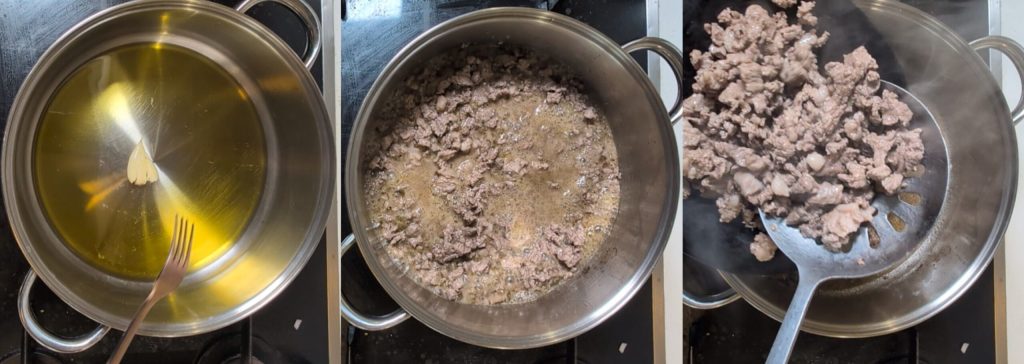
The ragù: a slow and fragrant cooking.
In the same pot, with the oil flavored by the meat, pour the vegetable mince and sauté over low heat, until soft and golden.
Add the browned meat again and deglaze with a generous glass of full-bodied red wine.
Let the alcohol evaporate, then add the tomato sauce, the bay leaves broken in half (for a more intense aroma), and half a glass of water.
Lower the heat and let the ragù cook for at least 1 and a half hours, or until it is well reduced, thick, and fragrant.

The béchamel: a creamy embrace.
While the ragù cooks slowly, prepare the béchamel. In a saucepan, melt the butter over low heat.
Add the sifted flour and mix vigorously with a whisk, forming the roux.
Cook the roux for a couple of minutes, until golden.
Pour the hot milk in a thin stream, continuing to stir with the whisk to avoid lumps.
Cook the béchamel over low heat, stirring continuously, until it has thickened. Add salt and nutmeg to taste.

The assembly of the lasagna: a work of art.
In a rectangular baking dish, spread a thin layer of ragù on the bottom.
Lay a layer of fresh lasagna sheets, then a layer of ragù, one of béchamel, and a generous sprinkle of grated Parmigiano Reggiano.
Repeat the layers until the ingredients are used up, finishing with a layer of béchamel and plenty of Parmigiano.
Bake the lasagna in a preheated oven at 356°F for about 30-40 minutes, or until golden and well-heated.
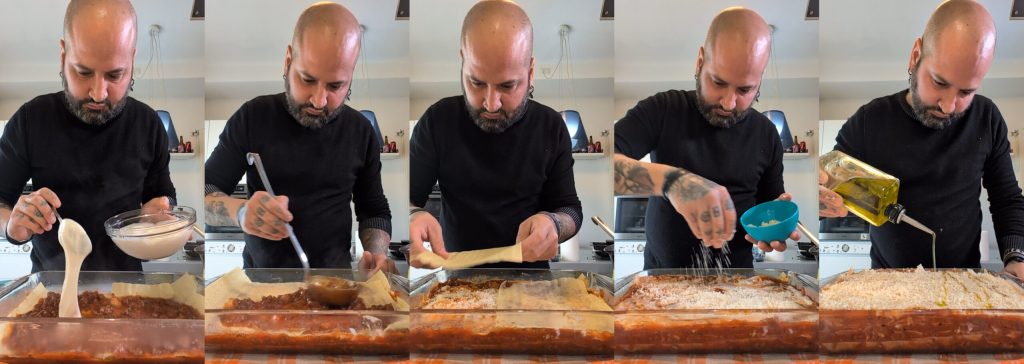
Resting, plating, and tasting: the triumph of flavors.
Remove the lasagna from the oven and let it rest for at least 15 minutes before cutting and serving.
This step is essential to allow the layers to settle and the flavors to meld.
Plate the portions and enjoy every bite of this lamb ragù lasagna, a dish that warms the heart and delights the palate.
Enjoy your meal!

Lamb ragù lasagna is a dish that lends itself to different interpretations and can be stored for enjoyment even in the following days.
Here are some useful tips for preserving your lasagna, tasty variations, and suggestions for a perfect result every time.
Storage:
In the refrigerator:
Leftover lasagna can be stored in the refrigerator for 2-3 days, in an airtight container.
Before consuming, reheat it in the oven or microwave.
In the freezer:
For longer storage, you can freeze the already cooked lasagna.
Divide it into single portions and wrap them in cling film or aluminum foil.
It will keep in the freezer for about 2-3 months.
To defrost, transfer it to the refrigerator the night before, or use the defrost function of the microwave.
Useful Tips:
For optimal preservation, allow the lasagna to cool completely before storing it in the refrigerator or freezer.
Variations:
Vegetarian:
Replace the lamb ragù with a mixed vegetable ragù (mushrooms, artichokes, zucchini, eggplant).
With different cheeses:
Try using Pecorino Romano or smoked Scamorza instead of Parmigiano. Add mozzarella between the layers of your lasagna.
With aromatic herbs:
Enrich the ragù with chopped fresh herbs, such as thyme, marjoram, or oregano. Add vegetables like spinach or artichokes between the layers.
Tips:
Fresh pasta:
If using homemade fresh lasagna sheets, make sure to roll them out thin for uniform cooking.
Well-reduced ragù:
The ragù must be well-reduced and thick to avoid the lasagna being too liquid.
Creamy béchamel:
The béchamel should be smooth and creamy, without lumps.
Rest before serving:
Let the lasagna rest for a few minutes before cutting and serving, to allow the layers to settle.
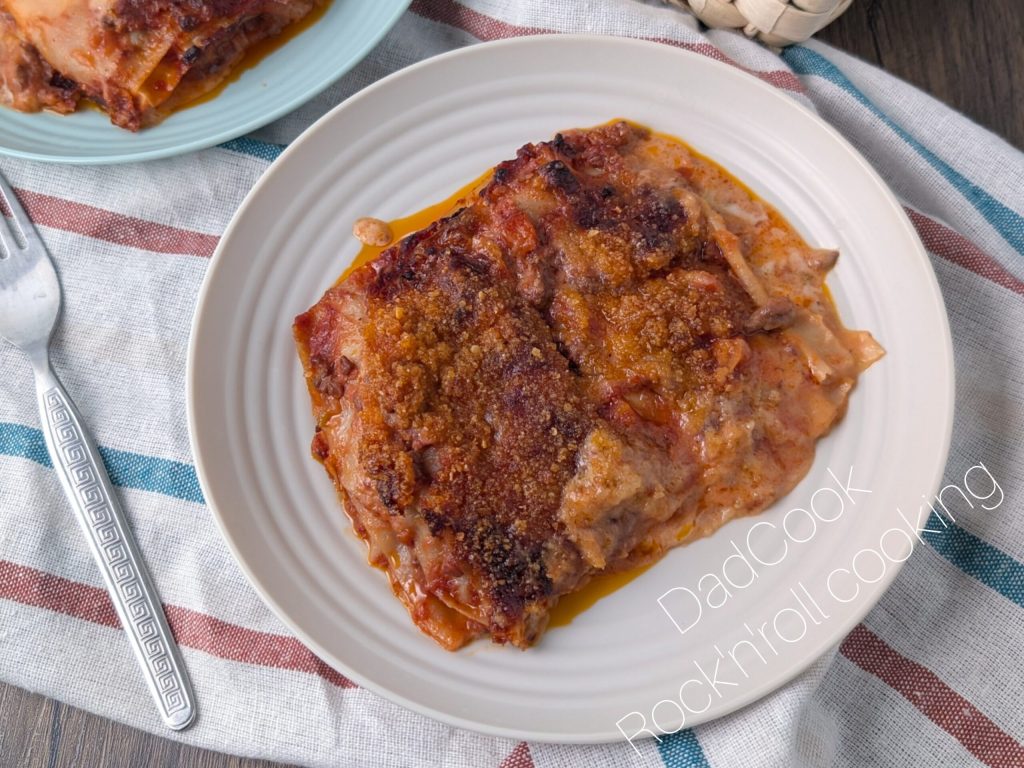
FAQ (Questions and Answers)
Do you still have any doubts about preparing the lamb ragù lasagna?
Here are some frequently asked questions that might clarify any doubts.
Can I prepare the lamb ragù in advance?
Yes, the lamb ragù can be prepared the day before and stored in the refrigerator. This way, the next day’s lasagna preparation will be even faster.

Can I replace red wine with something else?
If you don’t wish to use red wine, you can replace it with beef or vegetable broth. However, red wine gives the ragù a more intense and rich flavor.
How can I prevent the béchamel from forming lumps?
To prevent the formation of lumps, it is essential to melt the butter and flour well, creating the roux. Then, pour the hot milk in a thin stream, stirring continuously with a whisk.
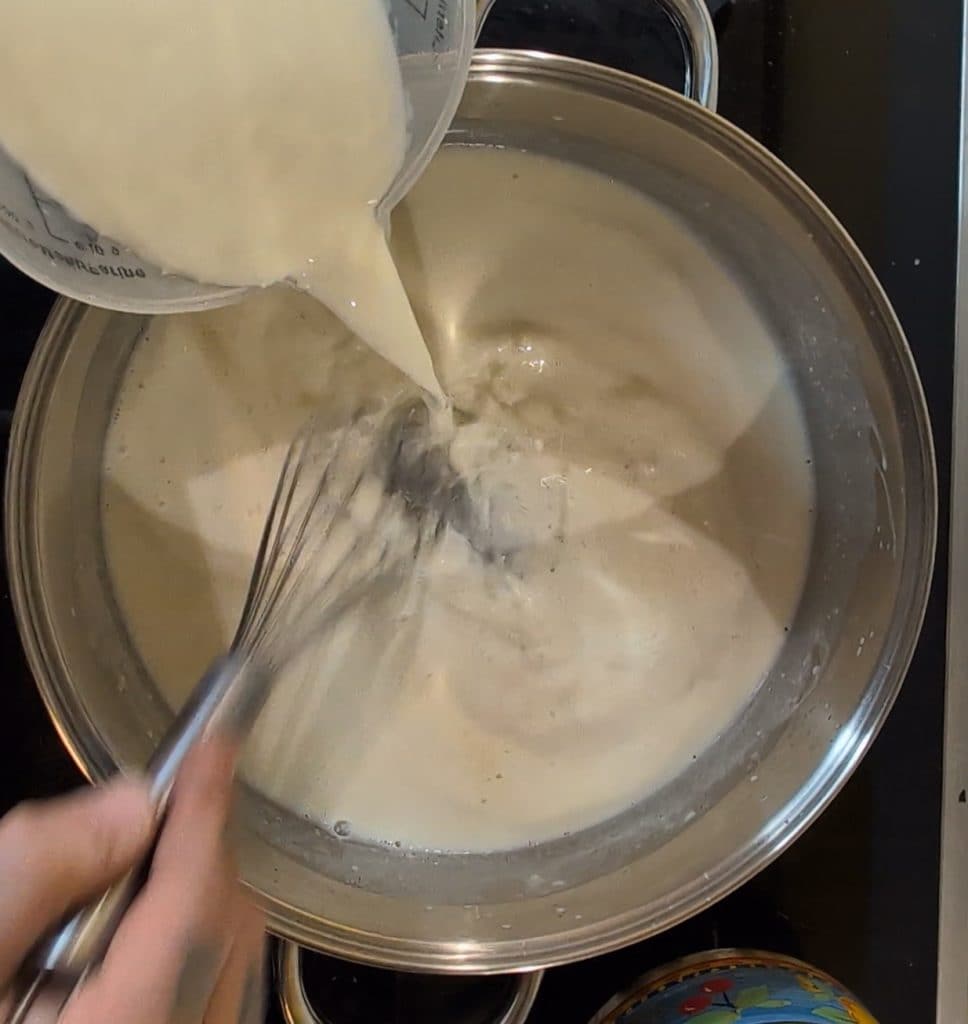
Can I add other vegetables to the ragù?
Absolutely yes! You can enrich the ragù with other vegetables to your liking, such as mushrooms, peppers, or peas.

Can the lasagna be made gluten-free?
Certainly, just use gluten-free lasagna sheets, and rice or corn flour to prepare the roux for the béchamel.
Can I use another type of meat?
Of course, the ragù can be prepared with beef, or with a mixture of beef and pork.
